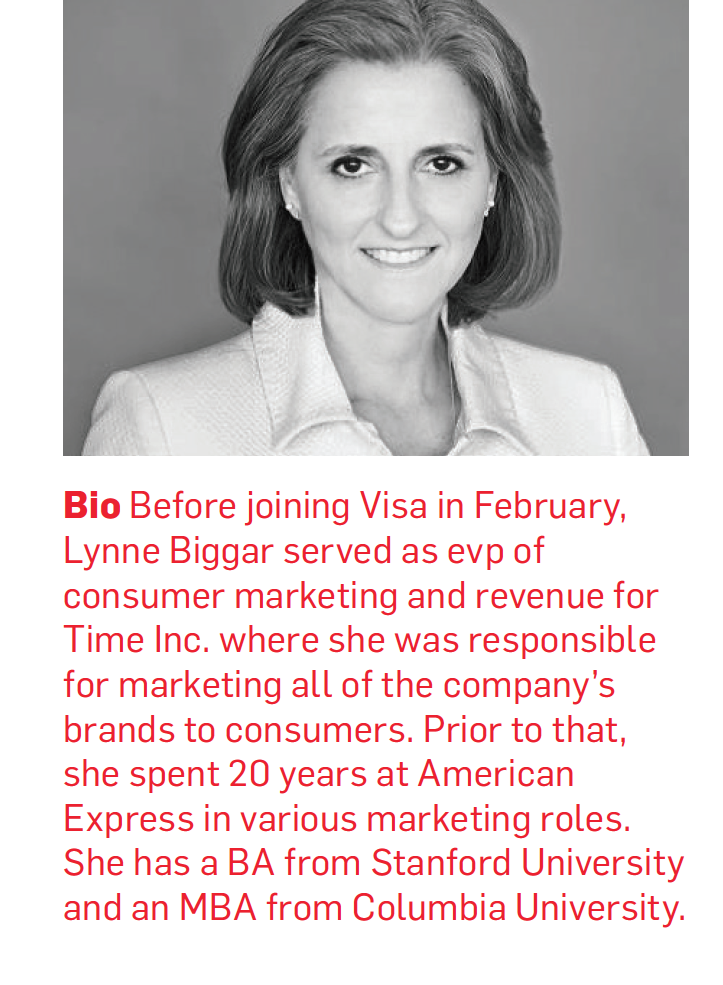
Athletes travel together to the games in BBDO’s humorous “Carpool” spot from Team Visa.
Visa is kicking off its 30-year anniversary of sponsoring the Summer Olympic Games in Rio with what might be its most tech-savvy innovation yet. Earlier this month, the brand introduced a new wearable device, the Visa payment ring, which will be worn in Rio by the 46 Olympic and Paralympic hopefuls that make up Team Visa.
 On Monday the company rolls out the first 105-second spot in its Olympic campaign, “Carpool” from BBDO, which humorously features 15 athletes from around the globe traveling together to the games. Adweek spoke with Lynne Biggar, Visa’s newly minted evp and chief marketing and communications officer (she joined in February) to hear about what she has planned for the Olympics as well as for the company.
On Monday the company rolls out the first 105-second spot in its Olympic campaign, “Carpool” from BBDO, which humorously features 15 athletes from around the globe traveling together to the games. Adweek spoke with Lynne Biggar, Visa’s newly minted evp and chief marketing and communications officer (she joined in February) to hear about what she has planned for the Olympics as well as for the company.
Adweek: What makes this Olympics effort special for Visa?
Lynne Biggar: We believe this campaign is the most ambitious, best integrated, most multichannel global Olympic campaign we’ve done so far. Our desire was to have it be very inspiring and be very much technology-led and technology-driven and leveraging Team Visa, which is a group of 46 athletes who embody these core values of acceptance, partnership and innovation in a playful, optimistic way. [In the spot], we highlight all the different ways that you can pay with Visa. You can click, swipe, dip and tap, [and we] use those words in the spot to show that paying with Visa is well beyond just paying at a traditional point of sale—it’s paying any way you want to, whenever you want to. And we use the Olympic athletes to get that message across for all of those different payment moments. Our customers and our clients are multichannel, multiscreen people. With “Carpool,” the spot being the anchor on the film side, we actually are enhancing that and turbocharging that with a lot of a digital media as well as focusing on social, earned and owned.
Does that mean Visa is making a more significant investment in digital this year?
I would say an increasing percentage of [our marketing spend] is going toward digital, and that’s just our general philosophy when we think about marketing. But we haven’t said ahead of time we want a certain allocation of our dollars to go to digital. We have said that our dollars should go in the places they’re going to drive the biggest and most impactful return for Visa. And we don’t come into something predisposed necessarily to the way we should spend our money. We let the data and the information be our guide and then imply a little bit of intuitive common sense to that as well as also being opportunistic if there’s good and interesting and innovative and cutting-edge opportunities that come our way. So it’s a little bit of art, just like marketing always is, and a lot of science, and you blend the two things together and you get a good outcome.
Tell us a bit about this payment ring.
All of the athletes will have this payment ring, and they’ll be able to use it around the Olympic Village and the games. Anywhere where an NFC [near field communication]-enabled terminal is, they can just tap the ring and off they go to pay. We use the Olympics as a means to put a spotlight on new payment technology, and we’re absolutely doing that in this Olympics as well.
Is the ring cute? Would you wear it?
I am actually looking at a ring here, and it’s pretty awesome. It comes in two colors right now, white and black. Another cool thing about it is it doesn’t have to be recharged. It never needs a battery. And it’s waterproof. So Missy Franklin, who is on the USA swim team and also another Team Visa athlete, can dive in the pool and wear her ring as she does it. It’s pretty cool looking. I actually really like it. I would wear it, and I’m picky.

In 1988, Visa launched the pithy tag “Because the Olympics don’t take American Express.”
Is there something about this effort, or any plans that you have with the Olympics, that are emblematic of the marketing that you want to do with Visa?
I think the hallmarks that you’ll see of mine are the focus on multichannel. We as a company are really evolving our thinking around use of a media as well as around target audience, and a much more multitenant focus is critical to our success going forward, so that’s an emphasis of mine. And then along with that, to some extent, is the emphasis on ensuring we have a very clear call to action in all of our work. So going into the games, we are very clear on how we’re going to measure the success of all of the different activities we do, be it media, be it the activations that we have on site, be it the innovations that we are enabling and creating on site. A huge part of what we do at the Olympics is beyond media. It’s really about the actual Olympics experience.

This story first appeared in the June 20, 2016 issue of Adweek magazine.
Click here to subscribe.
“);
}
var re = /((http|https|ftp):\/\/[\w?=&.\/-;#~%-]+(?![\w\s?&.\/;#~%”=-]*>))/g;
var count = 1;
$.each(data.results, function(i, item) {
if(count $1 ‘);
tweet = tweet.replace(/(^|\s)@(\w+)/g, ‘$1@$2‘);
tweet = tweet.replace(/(^|\s).@(\w+)/g, ‘$1.@$2‘);
tweet = tweet.replace(/(^|\s)#(\w+)/g, ‘$1#$2‘);
// intents
var intents = “”;
intents = intents + ‘
- ‘;
- Reply
- Retweet
- Favorite
intents = intents + ‘
‘;
intents = intents + ‘
‘;
intents = intents + ‘
‘;
intents = intents + ‘
‘;
intents = intents.replace(/##ID##/g, item.id_str);
$(‘#kristinamonllos_tweets’).append(“
“+ tweet + “
“+intents+”
“);
count++;
}
});
});
}
});



